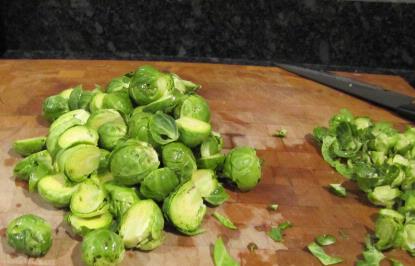After the first freeze Brussels sprouts turn even more delicious. Not so much that just anybody will eat them. I’m glad they don’t, because the boss and I can tear through what six or seven plants produce with no trouble whatsoever.
Brussels sprouts are supposed to take from “90-180” days to mature – that’s a wide time frame. Kind of like the amount of time it takes to download a movie or install a Microsoft product – essentially, you have no idea. I’ve had best results planting Brussels sprouts indoors then transplanting them in late spring. I don’t start harvesting until October, but can keep going until December if it doesn’t get too cold.
This year I’ve had an infestation of imported cabbage worms and a new visitor the cross-striped cabbage worm. The latter used to be a southern pest but has recently shown up here in New England (http://extension.umass.edu/vegetable/insects/cross-striped-cabbage-worm). The other standard cabbage pests lay their eggs one at a time, but the cross-striped lays them in bunches. So I’ve got lots. Despite squashing forays several times a week, they’ve managed to reduce the leaves of my sprouts to green swiss cheese. Nevertheless I’m getting a lot of lovely little cabbages.

I’ve heard that some people boil Brussels sprouts which seems a real waste, I stir fry or roast them with garlic and olive oil. I haven’t tried it, but I’d imagine that Brussels sprouts would cook up nicely on a grill. On the subject of cooking with fire, Brussels sprouts, I’ve learned, are an acceptable part of the “Paleo” diet.
The “Paleo” diet is an intellectualized Atkins diet. It’s short for paleolithic, but does not mean that practitioners eat old rocks (like there’s any other kind). The basic claim is that our body’s digestive system evolved over several million years along with a particular diet. To be most healthful we should follow this diet.
The paleolithic era began roughly 2.6 million years ago and continued up until the dawn of agriculture, roughly ten or eleven thousand years ago. During that period several different species of our genus as well as a few other genera of hominins began in Africa then spread throughout the world. To pretend that they had a unified diet is silly. Presumably the “paleo” diet is really based on a hunter-gatherer diet as practiced by Homo sapiens in the years shortly before agriculture when effective tools had been developed.
Why would one want to eat that? It is felt that hunter gatherers suffered fewer of the ailments of our sedentary, carb-centered diet. This is almost undoubtedly true. Like most humans before the twentieth century, they didn’t live long enough.
But what to eat? Without becoming hunter gatherers, one must select food that seems as if it could have been hunted and gathered. Foods like cow, Brussels sprouts and bacon. Grains and potatoes are out – though certainly paleolithic gatherers in Peru could have found them.
These foods are wonderfully ironic though. They are nothing like their wild ancestors because they’ve gone through thousands of generations of careful selection by humans – we’ve forced them to “evolve” in a way. Yet practitioners seem to believe that we alone haven’t changed – our guts are adapted to diets ending some tens of thousands of years ago. Since then our digestive systems have gone into some sort of stasis.
But I can’t argue that Brussels sprouts are delicious and they might even be good with bacon, a salted and preserved meat.


